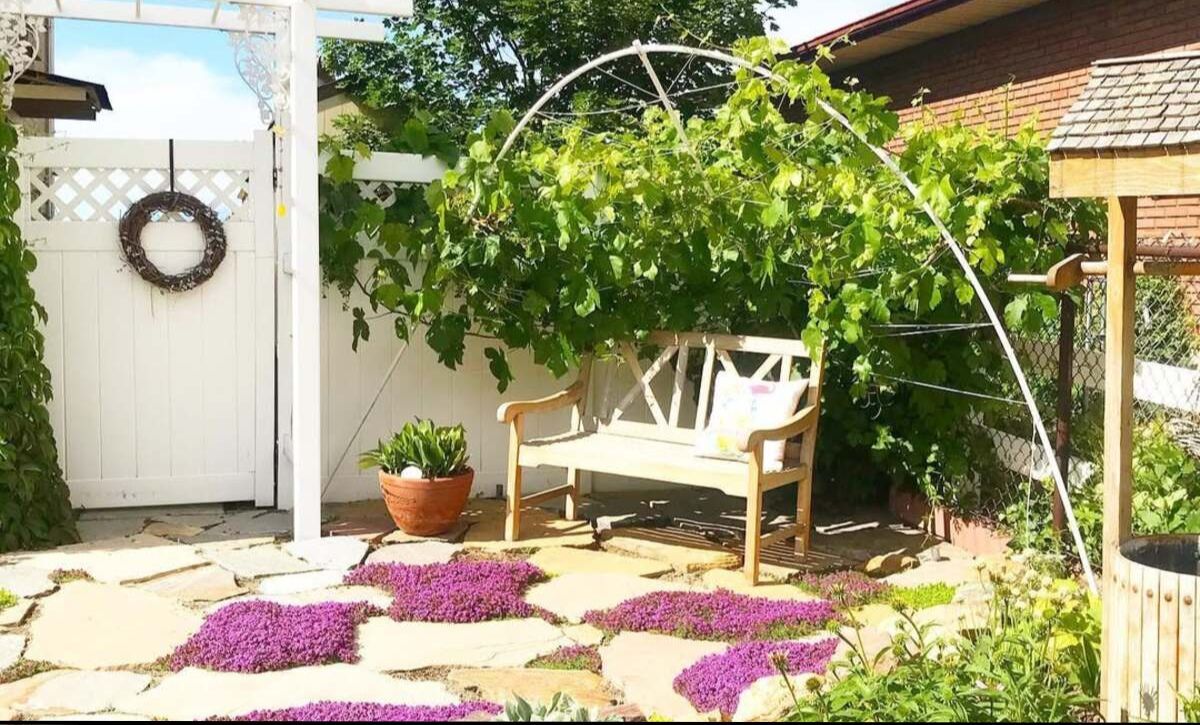Have you ever wondered what brings butterflies to your garden?
It’s all about the plants — butterflies tend to hang out in places with plenty of nectar and shelter for their delicate wings.
By adding butterfly plants to your existing flowers and shrubs, you can create a safe space for these beautiful creatures to live. They are the most beautiful beneficial insects in the world.
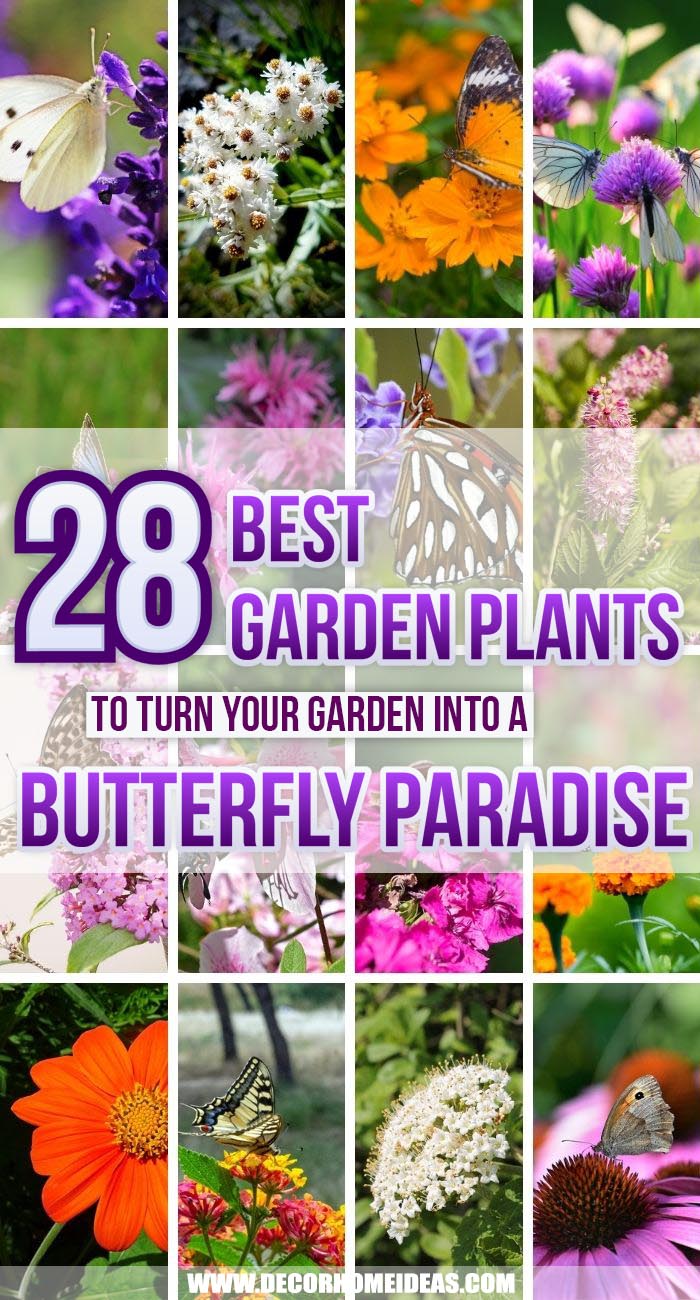
Before you know it, your yard will be buzzing with color and life.
If you want to spruce up your garden, don’t miss these posts:
- 30 Amazing Perennials That Bloom All Summer
- 35+ Beautiful Sunflower Garden Ideas To Add Happy Vibes To Your Home
- 40 Amazing Rose Garden Ideas For Your Backyard
Tip: You can buy a beautiful collection of butterfly plants ( Milkweed ) blooming in different colors – HERE
Let’s dive into the gallery with all these flowering plants that attract butterfly species and we’ll help you create the most beautiful butterfly garden in the neighborhood.
1. Azaleas

If you live in a region with swallowtail butterflies, consider planting azaleas.
With its large, colorful flowers, this flowering shrub brings in a variety of fluttering creatures; it’s also a beautiful addition to your garden.
It can reach 5 feet tall, so it’s a great choice if you have lots of space.
2. Bee Balm ( Monarda Fistulosa )

You’ll know when you walk by a bee balm plant — it’s known for its distinct, sweet fragrance.
The butterflies love it, too. They’re not the only ones; you can also expect the pretty pink blooms to bring in bees, hummingbirds, and other types of small birds.
3. Black-eyed Susan ( Rudbeckia )

Are you looking to add a bold pop of color to your garden?
Try planting rudbeckia, which is better known as the black-eyed Susan. The brilliant yellow flowers are beautiful, but they’re also strong enough to support the weight of the butterfly while it feeds.
As a bonus for you, rudbeckia plants are a breeze to grow.
4. Blue Mist Flower ( Conoclinium Coelestinum )

Bring butterflies and long-lasting blooms to your yard with the blue mist flower.
The feathery, delicate petals emerge in the spring and last well into the fall.
They tend to attract the queen butterfly, which features large wings and bold orange coloring.
5. Blue Porterweed ( Stachytarpheta Jamaicensis )

The blue porterweed contains a nectar that brings in a wide variety of butterflies.
It’s also a food source for Tropical Buckeye caterpillars, so you can nurture the entire butterfly life cycle.
With its brilliant green stems and pretty purple blooms, the blue porterweed is a convenient option for ground cover.
6. Butterfly Bush (Buddleia davidii)

It’s easy to see why this gorgeous plant is called a butterfly bush — when it blooms, it creates large clusters of flowers.
Butterflies flock to the flowers to drink the nectar; they tend to prefer the varieties with light purple blooms.
This plant can spread quickly, so it’s important to deadhead it regularly.
7. Chives (Allium schoenoprasum)

Home chefs know that chives are a must-have addition to an herb garden, but did you know that butterflies love them, too?
As chives grow, they form round, beautiful flowers that are a delicious food source for winged creatures.
If you live in a cold area, try the hardy garlic chive.
8. Pale Purple Coneflower ( Echinacea Pallida )
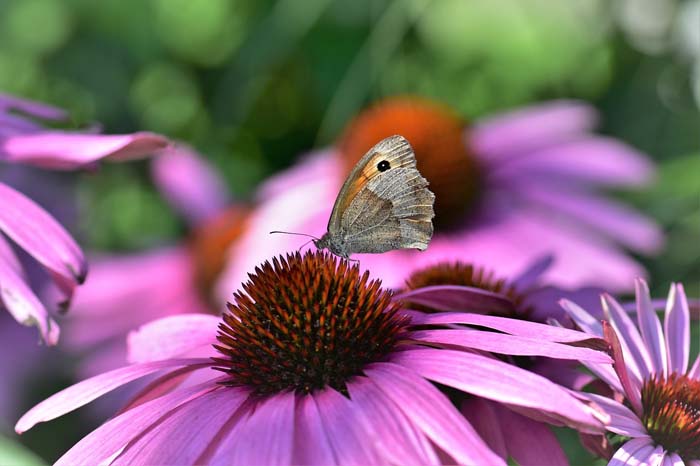
You’ll know the pale purple coneflower when you see it — true to its name, it features a cone-shaped center.
This sturdy structure is a perfect place for butterflies to rest while they eat the nectar which makes it a heaven on Earth for pollinator species.
Coneflowers are easy to grow and maintain, so you can keep your distance and watch the butterflies and hummingbirds at work.
9. Cosmos ( Cosmos Sulphureus )

Hoping to attract monarch butterflies? Try planting the cosmos flower.
These pretty, colorful blooms brighten your garden, and the tiny tubular structures in the center are filled with nourishing nectar.
Cosmos are easy-to-grow annuals that require little to no care. They are native plants that create a natural butterfly habitat especially for the Monarch butterfly.
10. Sapphire Flowers ( Duranta Erecta )

Sapphire flowers are another popular butterfly nectar plant. It’s known for its blooms, which cascade down vines in clusters.
This scrambling shrub is ideal for fences and pergolas.
Some varieties also produce yellow and orange berries, adding an extra burst of color to your outdoor space.
11. Elderberry (Sambucus nigra)
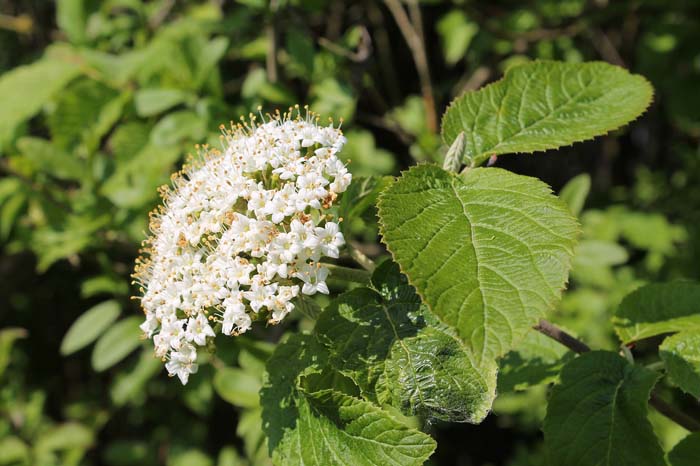
Feed the butterflies and your family with the elderberry plant.
This lovely shrub produces enormous clusters of tiny flowers — butterflies and bees can’t resist landing to drink the nectar. When the plant blooms, it produces berries that are perfect for making jelly and syrup.
As long as you cut back the plants in the winter, they’ll come back better than ever in the spring.
12. Fennel (Foeniculum vulgare)

If you live in an area with native swallowtail caterpillars, consider planting fennel.
The leaves are a popular food source for the caterpillars, and the thick, bushy growth provides shelter and natural habitat. Before long, you’ll start seeing brand-new butterflies popping up in the garden.
While you wait, you can add fennel to your salads and Indian recipes.
13. Stiff Goldenrod ( Oligoneuron Rigidum )
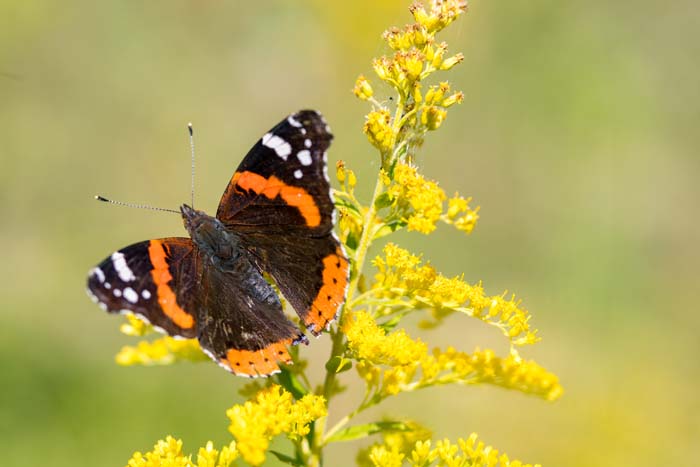
Encourage monarch butterflies to flock to your yard by planting stiff goldenrod.
As the name suggests, these plants are strong and stable — a perfect landing zone.
The flowers have high levels of nectar, so you’re likely to see butterflies and bees coming in to eat.
These yellow blooms are a good option if you have challenging soil; they thrive in a variety of harsh conditions.
14. Lantana

Did you know that butterflies are attracted to the fragrance of nectar?
Take advantage of this trait by planting lantana. The orange and yellow flowers smell sweet, so butterflies know to come in for a meal.
Choose from annual and perennial versions, depending on where you live; the lantana is available as a trailing and standing plant.
15. Lilac (Syringa)

There’s no mistaking the fantastic fragrance of lilacs.
As soon as the pretty purple flowers start to bloom, you’ll see butterflies coming in for a landing.
Your butterfly garden will smell fantastic during the flowering period, and the bright green leaves will add color the rest of the year.
16. Marigold

Marigolds are a mainstay in butterfly gardens; they provide plenty of nectar and a solid support system for butterflies.
As you’re choosing plants, make sure to opt for the French marigold.
Stay away from hybrid varieties, which don’t produce enough nectar to nourish butterflies.
17. Mexican Sunflower Torch ( Tithonia Rotundifolia or Speciosa )

With its vibrant petals, long blooming season, and sturdy stem, the Mexican sunflower torch is a haven for butterflies. Monarch butterflies, in particular, love to perch on the large centers while they eat.
These flowers can grow up to 6 feet tall, so they’re a lovely way to add height to your space.
18. Milkweed (Asclepias)

In the world of butterfly gardening, milkweed is a hero.
That’s because it’s the only type of plant that monarch caterpillars can eat. This native plant takes some patience to grow; you’ll need to focus on germinating the seeds for at least a month.
When they take, however, the plants are ready for caterpillars in just two months.
19. Oregano (Oreganum vulgare)

Chef’s gardens are always stocked with oregano, an herb that adds a bold flavor to sauces and meats.
The plant also brings in butterflies, who come to eat from the flowers.
Talk to your local nursery about the right variety for your location; in some areas, decorative oregano is better for butterflies than edible oregano.
20. Garden Phlox

Add fragrance to your garden with the garden phlox, a sweet-smelling flower that blooms in the summer.
The tiny flowers also bring in butterflies and bees, ensuring that your butterfly garden will be a hive of activity throughout the warmer months.
21. Aster (Asteraceae)

The aster is another key part of a thriving garden; they provide food for caterpillars and butterflies.
The stems are strong, providing plenty of food and shelter for caterpillars and a solid landing zone for butterflies.
You’ll appreciate the lovely flowers, which come in a variety of colors.
22. Rose of Sharon (Hibiscus syriacus)

The vintage-style rose of Sharon adds a touch of charm to your cottage garden.
This perennial flower produces large blooms that make a big visual impact. Butterflies come for the nectar, and the large centers attract bees.
Plus, since the rose of Sharon is easy to grow, it’s perfect for beginning gardeners.
23. Mexican Bush Sage ( Salvia Leucantha )

In warm climates, the Mexican bush sage thrives.
With its long, spiky leaves and distinctive flowers that line tall stalks, this plant adds structure to a garden filled with soft shapes.
It also brings in butterflies and hummingbirds, so you’ll see plenty of action throughout the summer.
24. Spotted Joe Pye Weed ( Eutrochium Maculatum )

Don’t let the name fool you — the spotted Joe Pye weed is a beautiful addition to your garden.
The strong, sturdy plants can reach up to 10 feet, but they usually stay between 6-8 feet.
The flowers bring in a wide range of butterflies, including monarchs.
25. Stonecrop (Sedum)

Do you see many different types of butterflies in your area?
The stonecrop plant is a fantastic way to entice all of them to visit your garden.
This plant produces strong clusters of blooms with plenty of nectar for butterflies including skippers, monarchs, painted ladies, pearl crescents, and more.
26. Summersweet (Clethra alnifolia)

With the summersweet flower, everything you need to know is in the name — butterflies can’t resist the sweet nectar of the summer blooms.
This adorable plant features tiny, feathery spikes that add an interesting touch of texture to your garden plot.
27. Pearly Everlasting (Anaphalis margaritacea)

If you’re hoping to encourage caterpillars to make a home in your garden, plant the pearly everlasting flower.
This vintage plant grows strong, plentiful leaves that are a favorite food source of painted lady and American lady caterpillars as they transform into butterflies.
28. Yarrow (Achillea millefolium)

As butterflies move from place to place, they seek plants that offer shelter from the elements.
Help them by planting yarrow; the lush foliage offers plenty of protection. Since yarrow is a perennial, it’s an easy way to keep your garden in good shape.
All these butterfly plants will help you be a one-of-a-kind butterfly gardener and enjoy all the colors in your garden together with the pride you’ve created a butterfly habitat and helped nature do its work.







